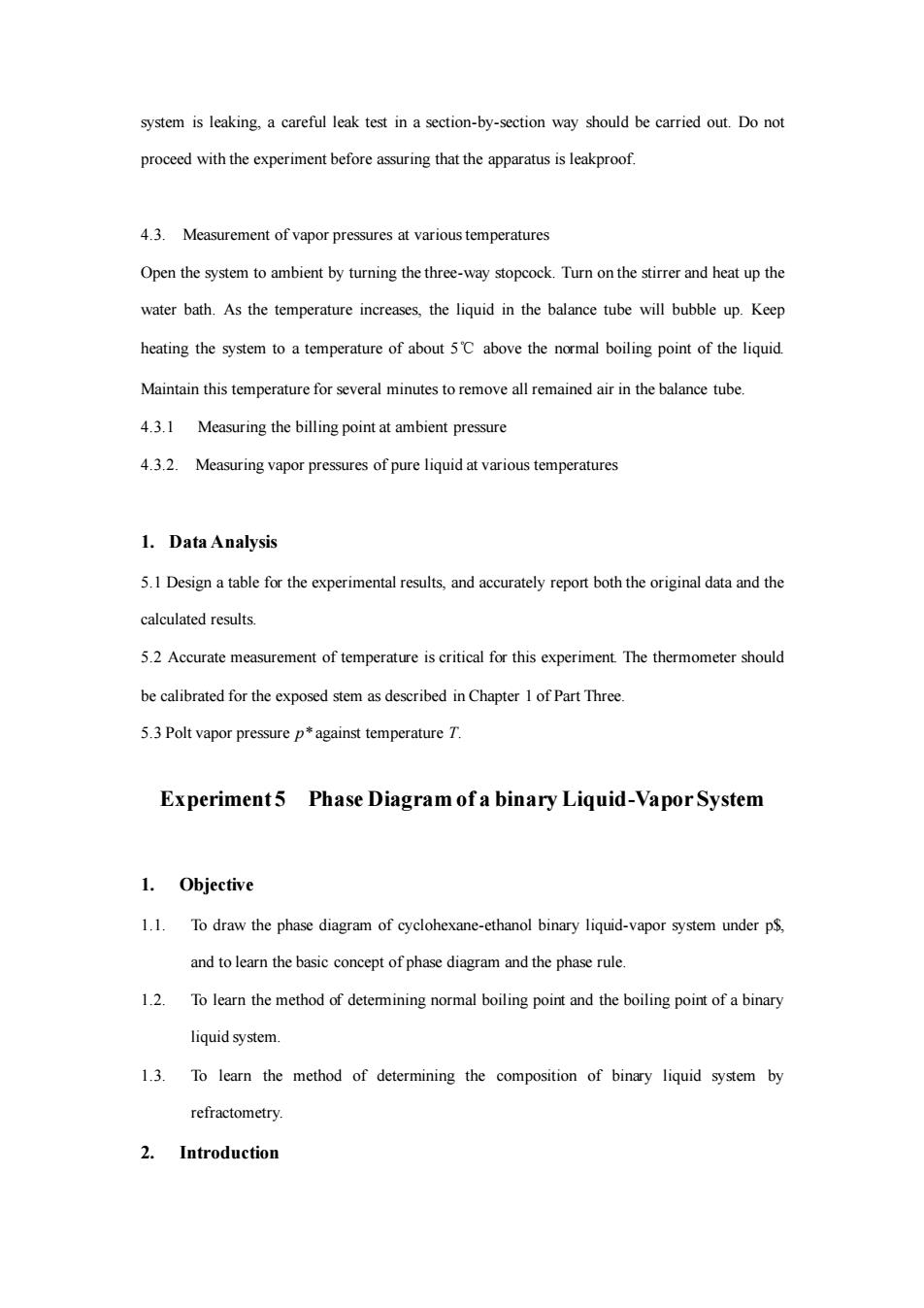
system is leaking.a careful leak test in a section-by-section way should be carried out.Do not proceed with the experiment before assuring that the apparatus is leakproof. 4.3.Measurement of vapor pressures at various temperatures Open the system to ambient by turning the three-way stopcock the stirrer and heat up the water bath.As the temperature increases,the liquid in the balance tube will bubble up.Keep heating the system to a temperature of about 5C above the normal boiling point of the liquid Maintain this temperature for several minutes to remove all remained air in the balance tube. 4.3.1 Measuring the billing point at ambient pressure 4.3.2.Measuring vapor pressures of pure liquid at various temperatures 1.Data Analysis 5.1Design a table for the experimental results,and accurately report both the original data and the calculated results 5.2 Accurate measurement of temperature is critical for this experiment.The thermometer should be calibrated for the exposed stem as described in Chapter 1of Part Three 5.3 Polt vapor pressurepagainst temperature T. Experiment 5 Phase Diagram of a binary Liquid-Vapor System 1.Objective 1.1.To draw the phase diagram of cyclohexane-ethanol binary liquid-vapor system under p and the basic concept ofphase diagram and the phase rue 1.2.To learn the method of detemmining normal boiling point and the boiling point of a binary liquid system 1.3.To learn the method of determining the composition of binary liquid system by refractometry. 2.Introduction
system is leaking, a careful leak test in a section-by-section way should be carried out. Do not proceed with the experiment before assuring that the apparatus is leakproof. 4.3. Measurement of vapor pressures at various temperatures Open the system to ambient by turning the three-way stopcock. Turn on the stirrer and heat up the water bath. As the temperature increases, the liquid in the balance tube will bubble up. Keep heating the system to a temperature of about 5℃ above the normal boiling point of the liquid. Maintain this temperature for several minutes to remove all remained air in the balance tube. 4.3.1 Measuring the billing point at ambient pressure 4.3.2. Measuring vapor pressures of pure liquid at various temperatures 1. Data Analysis 5.1 Design a table for the experimental results, and accurately report both the original data and the calculated results. 5.2 Accurate measurement of temperature is critical for this experiment. The thermometer should be calibrated for the exposed stem as described in Chapter 1 of Part Three. 5.3 Polt vapor pressure p* against temperature T. Experiment 5 Phase Diagram of a binary Liquid-Vapor System 1. Objective 1.1. To draw the phase diagram of cyclohexane-ethanol binary liquid-vapor system under p$, and to learn the basic concept of phase diagram and the phase rule. 1.2. To learn the method of determining normal boiling point and the boiling point of a binary liquid system. 1.3. To learn the method of determining the composition of binary liquid system by refractometry. 2. Introduction
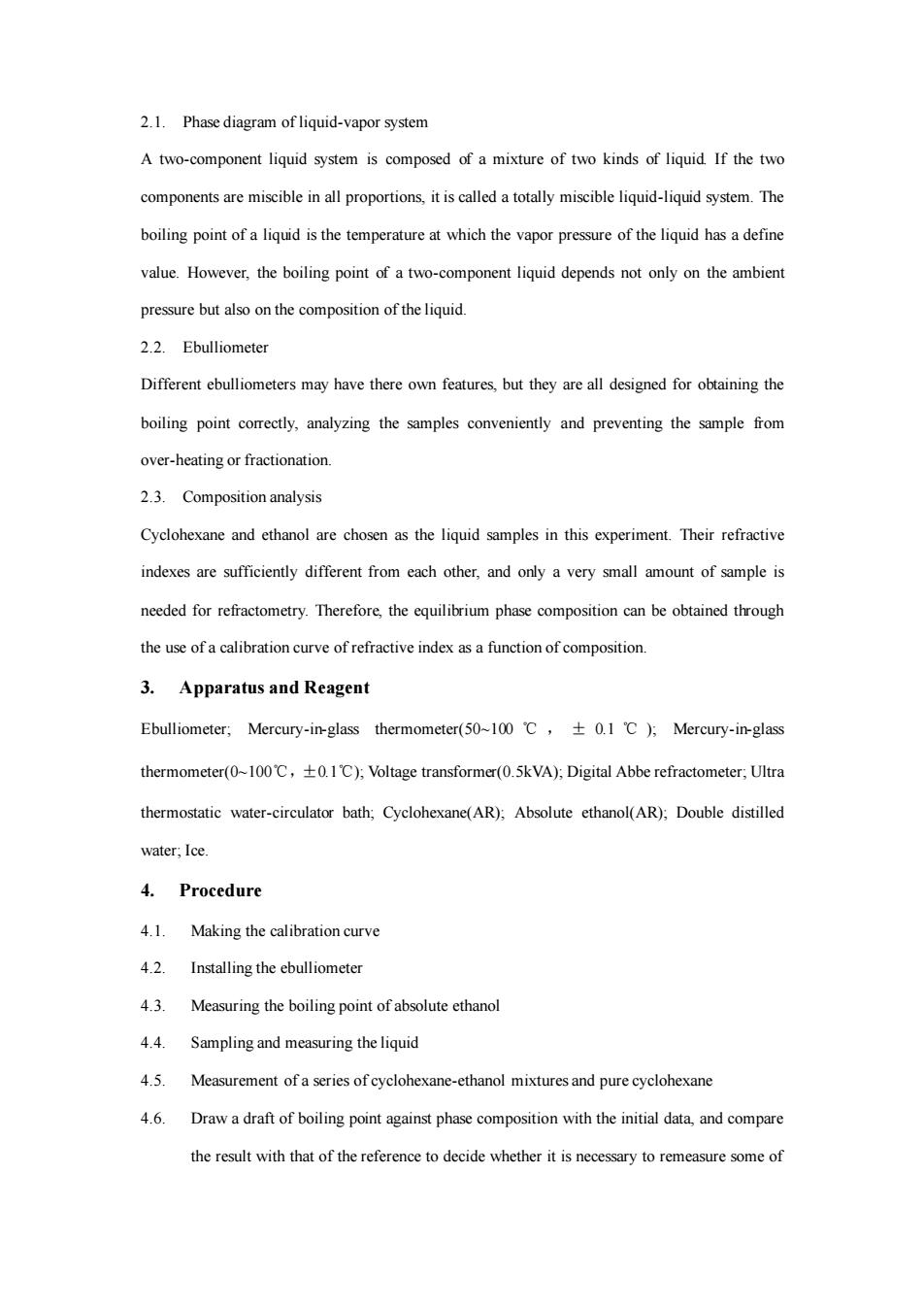
2.1.Phase diagram of liquid-vapor system A two-component liquid system is composed of a mixture of two kinds of liquid If the two components are miscible in all proportions,it is called a totally miscible liquid-liquid system.The boiling point of aliquid is the temperature at which the vapor pressure of the liquid has a define value.However,the boiling point of a two-component liquid depends not only on the ambient pressure but also on the composition of the liquid. 2.2.Ebulliometer Different ebulliometers may have there own features,but they are all designed for obaining the boiling point comrectly,analyzing the samples conveniently and preventing the sample from over-heatingor fractiontion. 2.3.Composition analysis Cyclohexane and ethanol are chosen as the liquid samples in this experiment.Their refractive indexes are sufficiently different from each other,and only a very small amount of sample is needed for refractometry.Therefore,the equilibrium phase composition can be obtained through theuse of a calibration curve of refractive index asa function of composition. 3.Apparatus and Reagent Ebulliometer,.Mercury-inglass thermometer(50-1oo℃,±O.℃方Mercury-in-glas thermometer(-100C,1C)Voltage transformer(.5kVA):Digital Abbe refractometer,Ultra thermostatic water-circulator bath:Cyclohexane(AR):Absolute ethanol(AR):Double distilled water,Ice. 4.Procedure 4.1.Making the calibration curve 4.2.Installing the ebulliometer 4.3.Measuring the boiling point ofabsolute ethanol 4.4.Sampling and measuring the liquid 4.5.Measurement of a series of cyclohexane-ethanol mixtures and pure cyclohexane 4.6.Draw a draft of boiling point against phase composition with the initial data,and compare the result with that of the reference to decide whether it is necessary to remeasure some of
2.1. Phase diagram of liquid-vapor system A two-component liquid system is composed of a mixture of two kinds of liquid. If the two components are miscible in all proportions, it is called a totally miscible liquid-liquid system. The boiling point of a liquid is the temperature at which the vapor pressure of the liquid has a define value. However, the boiling point of a two-component liquid depends not only on the ambient pressure but also on the composition of the liquid. 2.2. Ebulliometer Different ebulliometers may have there own features, but they are all designed for obtaining the boiling point correctly, analyzing the samples conveniently and preventing the sample from over-heating or fractionation. 2.3. Composition analysis Cyclohexane and ethanol are chosen as the liquid samples in this experiment. Their refractive indexes are sufficiently different from each other, and only a very small amount of sample is needed for refractometry. Therefore, the equilibrium phase composition can be obtained through the use of a calibration curve of refractive index as a function of composition. 3. Apparatus and Reagent Ebulliometer; Mercury-in-glass thermometer(50~100 ℃,± 0.1 ℃ ); Mercury-in-glass thermometer(0~100℃,±0.1℃); Voltage transformer(0.5kVA); Digital Abbe refractometer; Ultra thermostatic water-circulator bath; Cyclohexane(AR); Absolute ethanol(AR); Double distilled water; Ice. 4. Procedure 4.1. Making the calibration curve 4.2. Installing the ebulliometer 4.3. Measuring the boiling point of absolute ethanol 4.4. Sampling and measuring the liquid 4.5. Measurement of a series of cyclohexane-ethanol mixtures and pure cyclohexane 4.6. Draw a draft of boiling point against phase composition with the initial data, and compare the result with that of the reference to decide whether it is necessary to remeasure some of
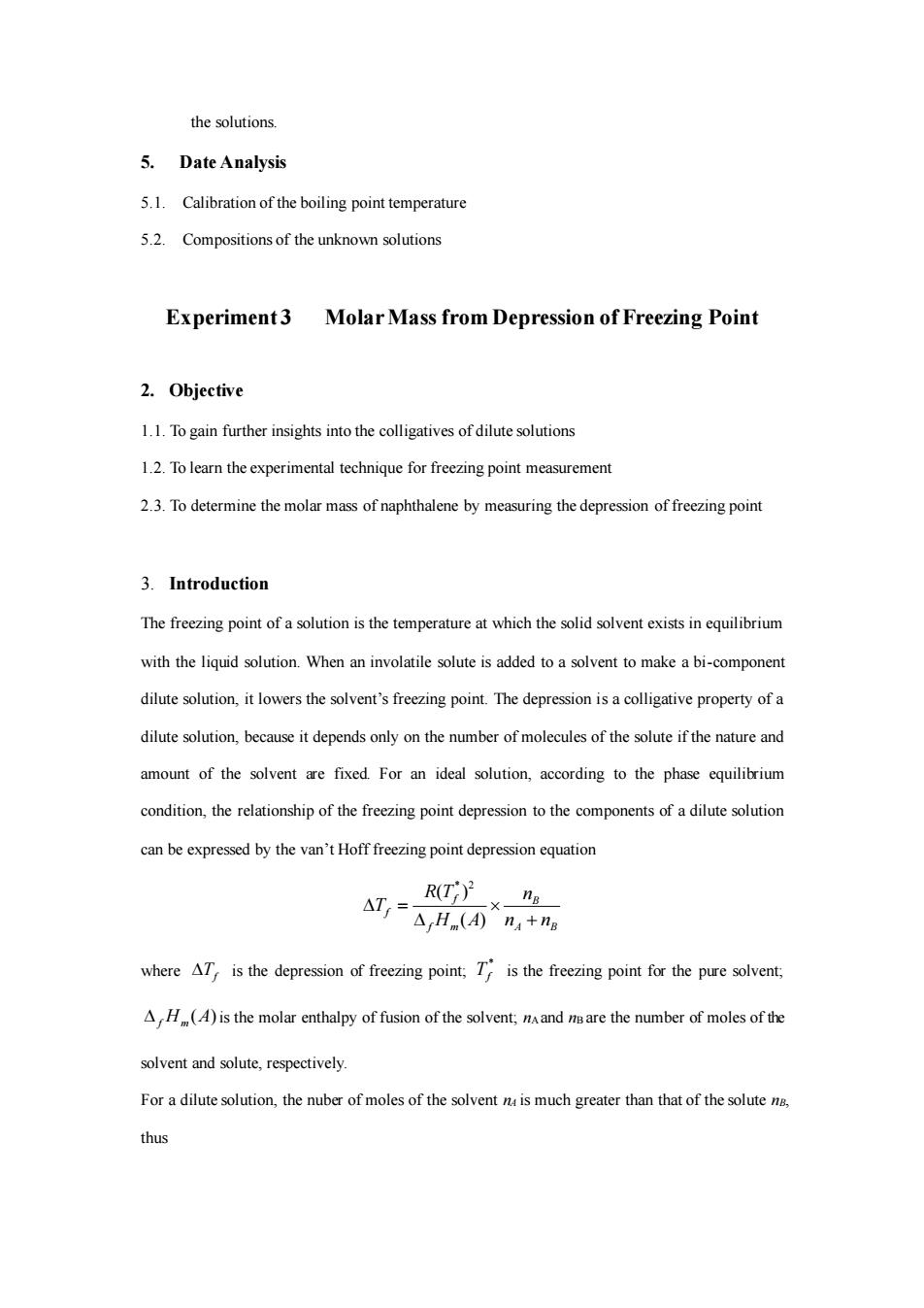
the solutions. 5.Date Analysis 5.1.Calibration of the boiling point temperature 5.2.Compositions of the unknown solutions Experiment3 Molar Mass from Depression of Freezing Point 2.Objective 1.1.To gain further insights into the colligatives ofdiluteoutions 1.2.To learn the experimental technique for freezing point measurement 2.3.To determine the molar mass of naphthalene by measuring the depression of freezing point 3.Introduction The freezing point of a solution is the temperature at which the solid solvent exists in equilibrium with the liquid solution.When an involatile solute is added toa solvent to make a bi-component dilute solution,it lowers the solvent's freezing point.The depression is a colligative property of a dilute soltion,because it dependsony on the number of molecules of the solute if the nature and amount of the solvent are fixed.For an ideal solution,according to the phase equilibrium condition,the relationship of the freezing point depression to the components of a dilute solution can be expressed by the van't Hoff freezing poin R(TY ATI= △yHn(A)n4+na where AT is the depression of freezing point.T is the freezing point for the pure solvent. AH()is the molar enthalpy of fusion of the solvent.mand are the number of moles of the solvent and solute,respectively. For a dilute solution,the nuber of moles of the solvent ris much greater than that of the solute thus
the solutions. 5. Date Analysis 5.1. Calibration of the boiling point temperature 5.2. Compositions of the unknown solutions Experiment 3 Molar Mass from Depression of Freezing Point 2. Objective 1.1. To gain further insights into the colligatives of dilute solutions 1.2. To learn the experimental technique for freezing point measurement 2.3. To determine the molar mass of naphthalene by measuring the depression of freezing point 3. Introduction The freezing point of a solution is the temperature at which the solid solvent exists in equilibrium with the liquid solution. When an involatile solute is added to a solvent to make a bi-component dilute solution, it lowers the solvent’s freezing point. The depression is a colligative property of a dilute solution, because it depends only on the number of molecules of the solute if the nature and amount of the solvent are fixed. For an ideal solution, according to the phase equilibrium condition, the relationship of the freezing point depression to the components of a dilute solution can be expressed by the van’t Hoff freezing point depression equation A B B f m f f n n n H A R T T + = ( ) ( ) * 2 where Tf is the depression of freezing point; * Tf is the freezing point for the pure solvent; H (A) f m is the molar enthalpy of fusion of the solvent; nA and nB are the number of moles of the solvent and solute, respectively. For a dilute solution, the nuber of moles of the solvent nA is much greater than that of the solute nB, thus
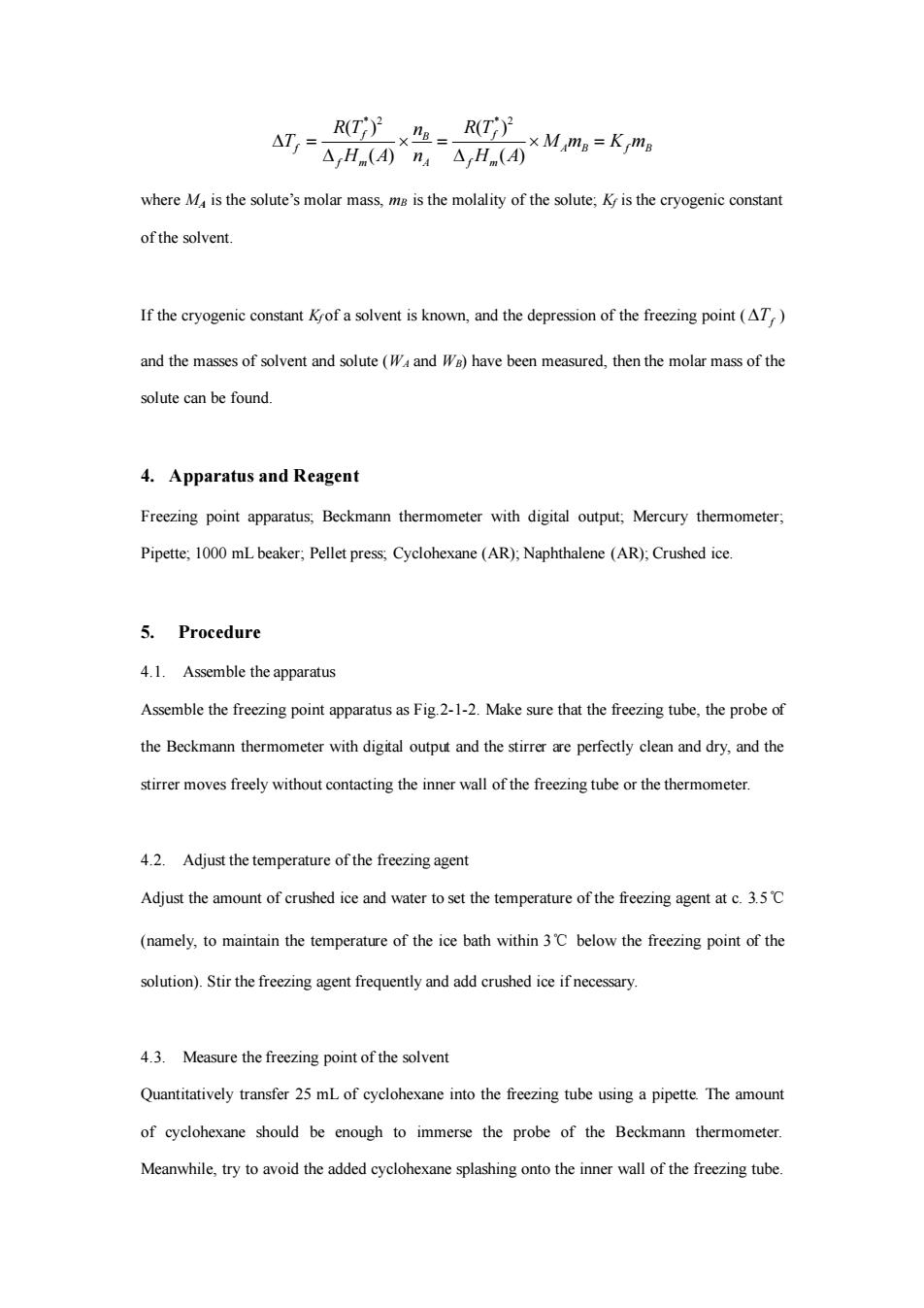
RT×=RY a=A,H④×元A,H④xMm,=Km, where M is the solute's molar mass,m is the molality of the solute:K is the cryogenic constant of the solvent If the eryogenic is known,and the depression of the freezing point (AT) and the masses of solvent and solute(W and Wa)have been measured,then the molar mass of the solute can be found. 4.Apparatus and Reagent Freezing point apparatus,Beckmann thermometer with digital output;Mercury themometer Pipette:1000 mLbeaker,Pellet press,Cyelohexane(AR):Naphthalene(AR)Crushed ice. 5.Procedure 4.1.Assemble the apparatus Assemble the freezing point apparatus as Fig.2-1-2.Make sure that the freezing tube,the probe of the Beckmann thermometer with digital outpu and the stiere perfectly clean and dry,and the stirrer moves freely without contacting the inner wall of the freezing tube or the thermometer. 4.2.Adjust the temperature ofthe freezing agent Adjust the amount of crushed ice and water to set the temperature of the freezing agent at c.3.5C (namely,to maintain the temperature of the ice bath within 3C below the freezing point of the 4.3.Measure the freezing point of the solvent Quantitatively transfer 25 mL of cyclohexane into the freezing tube using a pipette The amount of cyclohexane should be enough to immerse the probe of the Beckmann thermometer. Meanwhile,try to avoid the added cyclohexane splashing onto the iner wall of the freezing tube
A B f B f m f A B f m f f M m K m H A R T n n H A R T T = = = ( ) ( ) ( ) ( ) * 2 * 2 where MA is the solute’s molar mass, mB is the molality of the solute; Kf is the cryogenic constant of the solvent. If the cryogenic constant Kf of a solvent is known, and the depression of the freezing point ( Tf ) and the masses of solvent and solute (WA and WB) have been measured, then the molar mass of the solute can be found. 4. Apparatus and Reagent Freezing point apparatus; Beckmann thermometer with digital output; Mercury thermometer; Pipette; 1000 mL beaker; Pellet press; Cyclohexane (AR); Naphthalene (AR); Crushed ice. 5. Procedure 4.1. Assemble the apparatus Assemble the freezing point apparatus as Fig.2-1-2. Make sure that the freezing tube, the probe of the Beckmann thermometer with digital output and the stirrer are perfectly clean and dry, and the stirrer moves freely without contacting the inner wall of the freezing tube or the thermometer. 4.2. Adjust the temperature of the freezing agent Adjust the amount of crushed ice and water to set the temperature of the freezing agent at c. 3.5℃ (namely, to maintain the temperature of the ice bath within 3℃ below the freezing point of the solution). Stir the freezing agent frequently and add crushed ice if necessary. 4.3. Measure the freezing point of the solvent Quantitatively transfer 25 mL of cyclohexane into the freezing tube using a pipette. The amount of cyclohexane should be enough to immerse the probe of the Beckmann thermometer. Meanwhile, try to avoid the added cyclohexane splashing onto the inner wall of the freezing tube
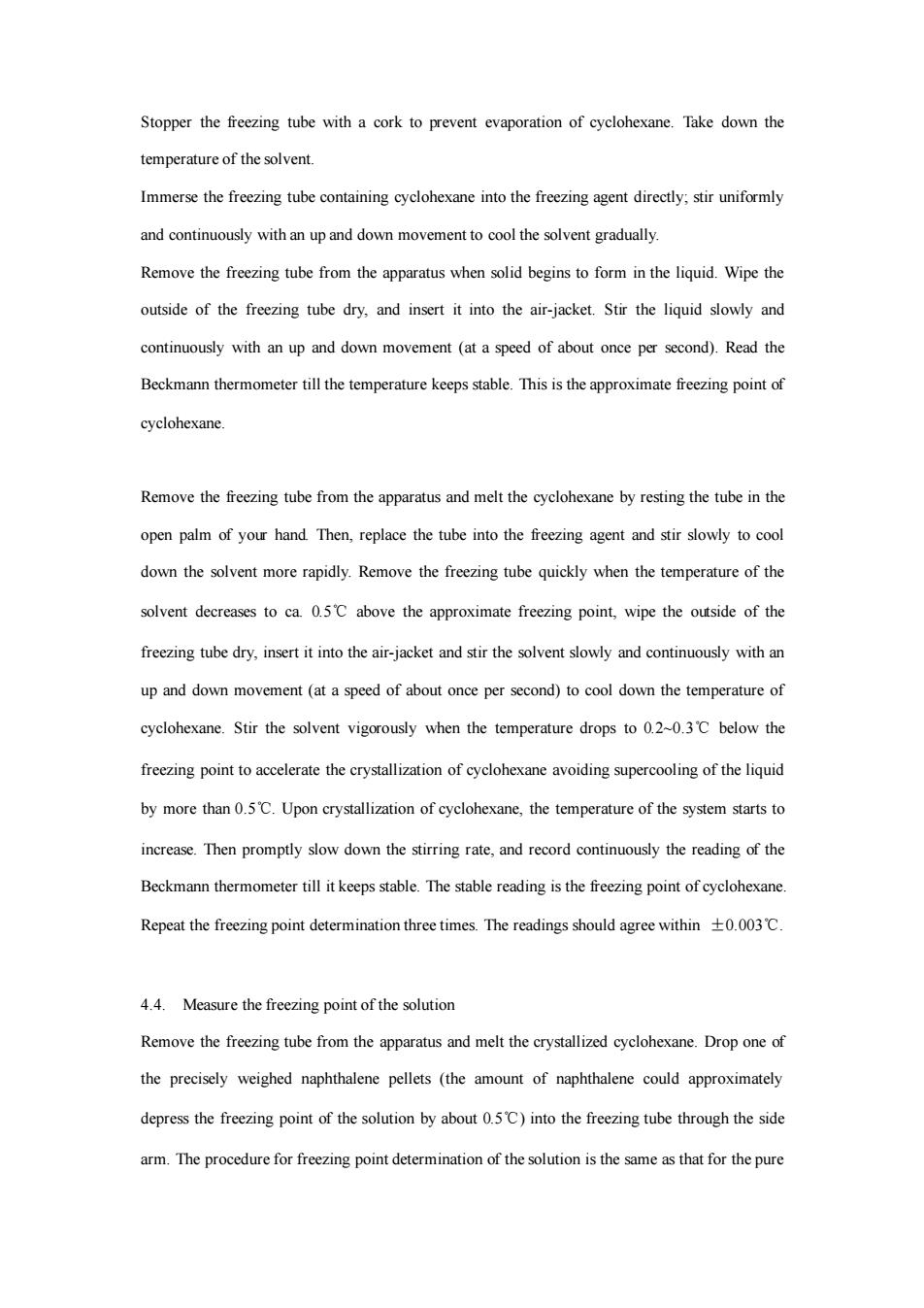
Stopper the freezing tube with a cork to prevent evaporation of cyclohexane.Take down the temperature of the solvent. Immerse the freezing tube containing cyclohexane into the freezing agent directly,stir uniformly and continuously with an up and down movement to cool the solvent gradually. Remove the freezing tube from the apparatus when solid begins to form in the liquid.Wipe the outside of the freezing tube dry.and insert it into the air-jacket.Stir the liquid slowly and continuously with an up and down movement(at a speed of about once per second).Read the Beckmann thermometer till the temperature keeps stable.This is the of cyclohexane. Remove the freezing tube from the apparatus and melt the cycohexane by resting the tube in the open palm of your hand Then,replace the tube into the freezing agent and stir slowly to cool down the solvent more rapidly.Remove the freezing tube quickly when the temperature of the solvent decreases to ca.5'C above the approximate freezing point,wipe the outside of the freezing tube dry.insert it into the air-jacket and stir the solvent slowly and continuously with an up and down movement(at a speed of about once per second)to cool down the temperature of cyclohexane.Stir the solvent vigorously when the temperature drops to0.below the freezing point to accelerate the crystallization of cyclohexane avoiding supercooling of the liquid by more than 5C.Upon crystallization of cyclohexane,the temperature of the system starts to ncrease.Then promptly sowdown the stirring rate,and record the reading of the Beckman thermometer till it keeps stable.The stable reading is the freezing point of yclohexane. Repeat the freezing point determination three times.The readings should agree within 003C. 4.4.Measure the freezing point of the solution Remove the freezing tube from the apparatus and melt the crystallized cyclohexane.Drop one of the precisely weighed naphthalene pellets (the amount of naphthalene could approximately depress the freezing point of the solution by about 05C)into the freezing tube through the side arm.The procedure for freezing point determination of is the same s that for the pure
Stopper the freezing tube with a cork to prevent evaporation of cyclohexane. Take down the temperature of the solvent. Immerse the freezing tube containing cyclohexane into the freezing agent directly; stir uniformly and continuously with an up and down movement to cool the solvent gradually. Remove the freezing tube from the apparatus when solid begins to form in the liquid. Wipe the outside of the freezing tube dry, and insert it into the air-jacket. Stir the liquid slowly and continuously with an up and down movement (at a speed of about once per second). Read the Beckmann thermometer till the temperature keeps stable. This is the approximate freezing point of cyclohexane. Remove the freezing tube from the apparatus and melt the cyclohexane by resting the tube in the open palm of your hand. Then, replace the tube into the freezing agent and stir slowly to cool down the solvent more rapidly. Remove the freezing tube quickly when the temperature of the solvent decreases to ca. 0.5℃ above the approximate freezing point, wipe the outside of the freezing tube dry, insert it into the air-jacket and stir the solvent slowly and continuously with an up and down movement (at a speed of about once per second) to cool down the temperature of cyclohexane. Stir the solvent vigorously when the temperature drops to 0.2~0.3℃ below the freezing point to accelerate the crystallization of cyclohexane avoiding supercooling of the liquid by more than 0.5℃. Upon crystallization of cyclohexane, the temperature of the system starts to increase. Then promptly slow down the stirring rate, and record continuously the reading of the Beckmann thermometer till it keeps stable. The stable reading is the freezing point of cyclohexane. Repeat the freezing point determination three times. The readings should agree within ±0.003℃. 4.4. Measure the freezing point of the solution Remove the freezing tube from the apparatus and melt the crystallized cyclohexane. Drop one of the precisely weighed naphthalene pellets (the amount of naphthalene could approximately depress the freezing point of the solution by about 0.5℃) into the freezing tube through the side arm. The procedure for freezing point determination of the solution is the same as that for the pure